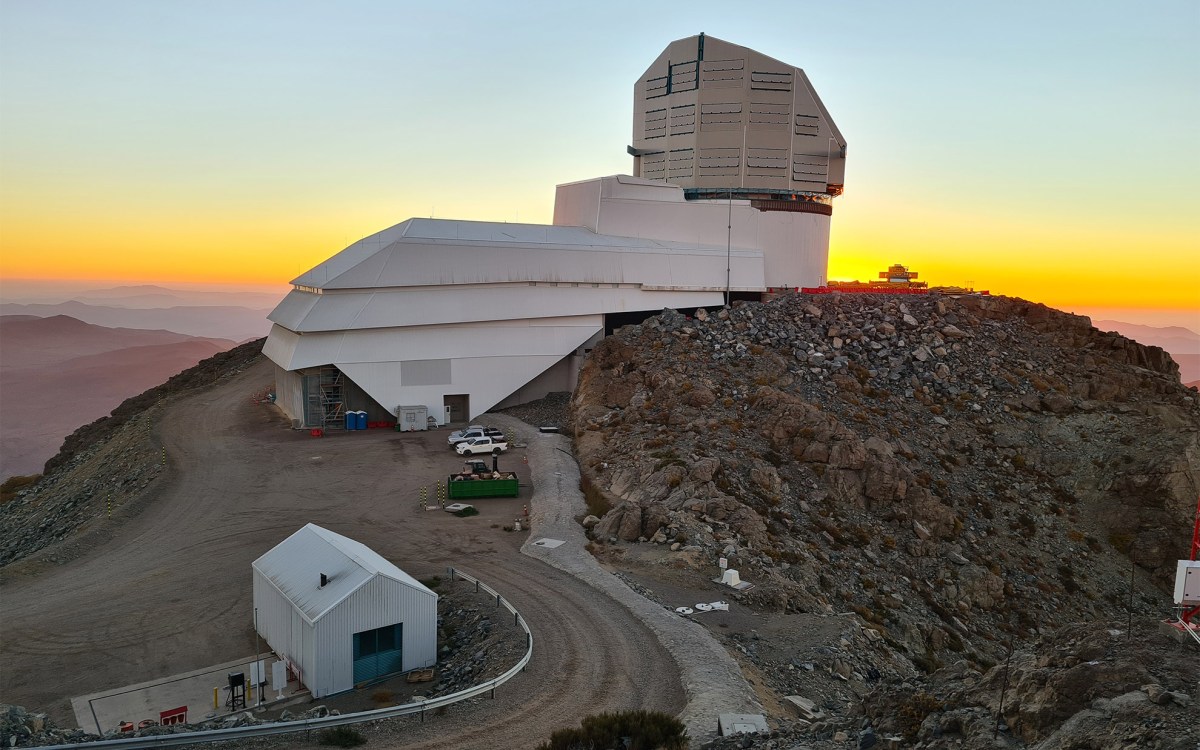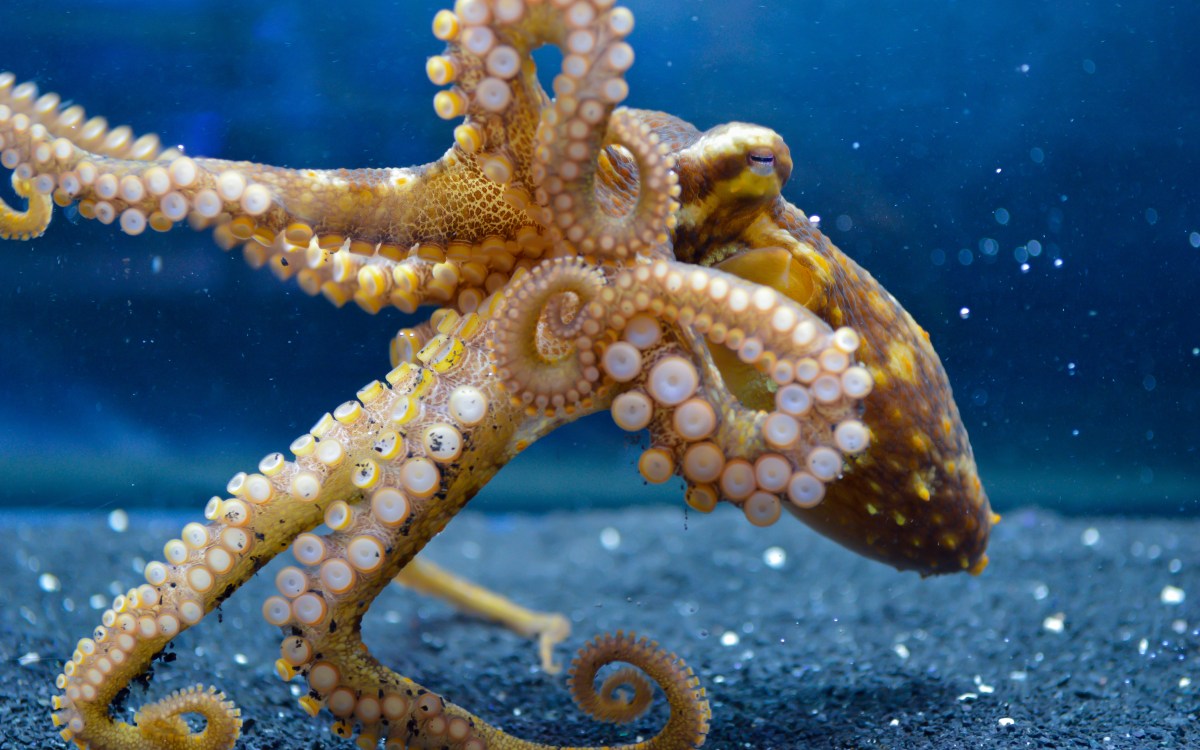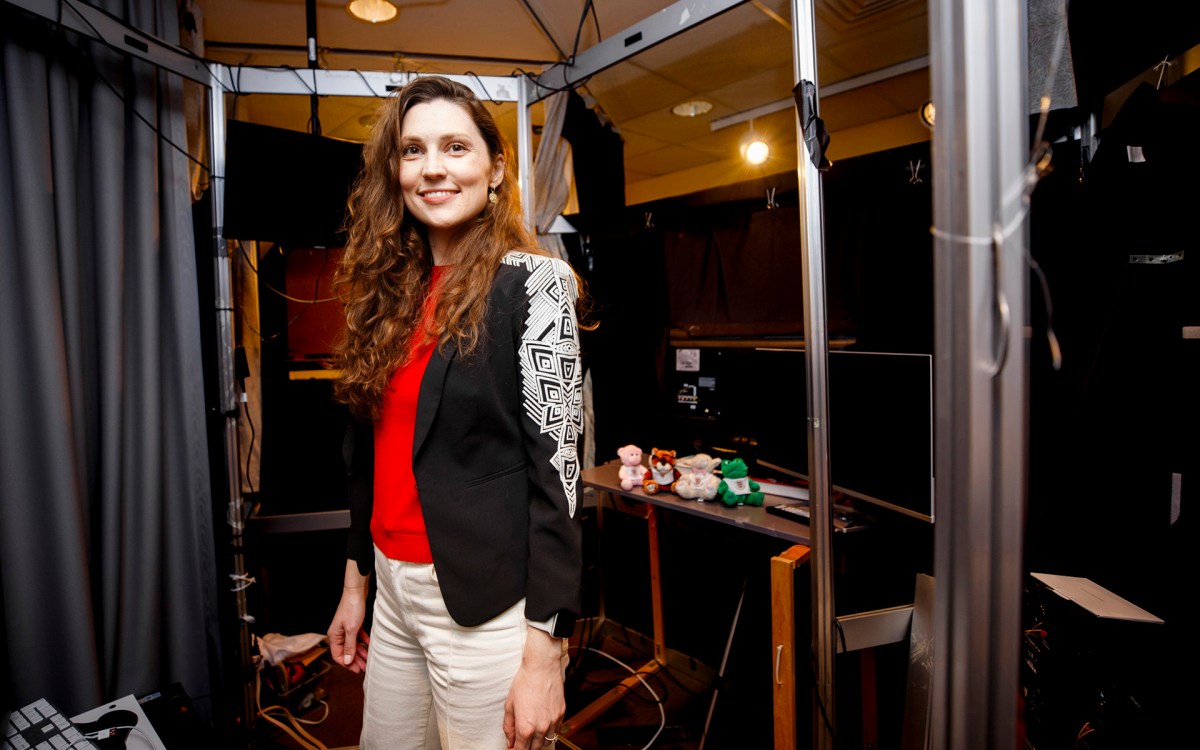Science & Tech
-

Can AI be as irrational as we are? (Or even more so?)
Psychologists found OpenAI’s GPT-4o showing humanlike patterns of cognitive dissonance, sensitivity to free choice

-

Stealing a ‘superpower’
Study finds some sea slugs consume algae, incorporate photosynthetic parts into their own bodies to keep producing nutrients

-

Reading skills — and struggles — manifest earlier than thought
New finding underscores need to intervene before kids start school, say researchers

-

Shining light on scientific superstar
Vera Rubin, whose dark-matter discoveries changed astronomy and physics, gets her due with namesake observatory, commemorative quarter
-

A taste for microbes
New research reveals how the octopus uses arms to sense chemical clues from microbiomes

-

Out of sight but not out of mind
By 15 months, children can learn the names of objects they’ve never seen

-
Bat die-off in Northeast still mysterious
There’ll be fewer bats in backyards across the Northeast this summer after a mysterious ailment drove starving bats from their caves in the dead of winter in a futile, desperate search for insects in the region’s frozen, bug-free landscape.
-
Solar eruption seen in detail
On April 9, the sun erupted and blasted a bubble of hot, ionized gas into the solar system. The eruption was observed in unprecedented detail by a fleet of spacecraft, revealing new features that are predicted by computer models but difficult to see in practice.
-
HMS introduces wilderness fellowship
Snake bites, lightning strikes, hypothermia, tick bites, and avalanche injuries are not mishaps you ordinarily associate with Harvard Medical School (HMS), or with life in Boston.
-
Mars’ water appears to have been too salty to support life
A new analysis of the Martian rock that gave hints of water on the Red Planet — and, therefore, optimism about the prospect of life — now suggests the water…
-
How to move out and stay green at same time
With the end of the academic year fast approaching, the temptation to purge all obsolete office and school materials is stronger than ever. But to maintain Harvard’s impressive 50 percent recycling rate, Harvard’s University Operations Services (UOS) wishes to remind the community to continue recycling all materials whenever possible. All old documents, books, folders, magazines, catalogs, cardboard, and boxes are recyclable; and after receptions, meetings, and parties, bottles, cans, cups, and containers can be recycled.
-
Costa Rican minister outlines plan to achieve carbon neutrality through reforms
Costa Rica’s environment minister outlined the Central American nation’s plans to become carbon neutral by 2021 through green reforms in energy, transportation, government, and private industry sectors.
-
Undergrads create ‘dirt-powered’ light for Africa
A team composed of Harvard students and alumni was among the winners of the World Bank’s Lighting Africa 2008 Development Marketplace competition, held in Accra, Ghana, from May 6 to 8, 2008. The team’s innovation, microbial fuel cell-based lighting systems suitable for sub-Saharan Africa, netted the Harvard group a $200,000 prize.
-
Ashton: A legacy written in trunk, limb, and leaf
They were in a bind, no doubt about it.
-
Zittrain speculates on Web’s trajectory
Jonathan Zittrain is a man with a passion for cyberspace and a concern for its future.
-
New journal highlights undergraduate research
Spanning topics as diverse as cancerous tumors and the overfishing of grouper in the Turks and Caicos Islands, a new journal aims to highlight the serious scientific research regularly undertaken…
-
Presidential election will bring change in federal stem cell policy
Embryonic stem cell research will likely have a more sympathetic ear in the White House after November’s presidential election, but a panel of speakers said last night that an era…
-
Study identifies food-related clock in the brain
In investigating the intricacies of the body’s biological rhythms, scientists at Beth Israel Deaconess Medical Center (BIDMC) have discovered the existence of a “food-related clock” which can supersede the “light-based”…
-
Harvard researchers selected for National Academy of Sciences membership
Eight Harvard faculty members this week were elected to membership in the National Academy of Sciences in recognition of their distinguished and continuing achievements in original research. The three women…
-
Humanities: From deconstruction to digitization
Malcolm Hyman, a research associate at the Max Planck Institute for the History of Science in Berlin, addressed a group of 20 listeners at the Barker Center about the theoretical challenges ahead for humanities computing — a fast-growing corner of scholarship in the classics, modern literature, and the arts that looks to computer science for analytical help.
-
Markey addresses ‘Future of Energy’
The chair of the U.S. House Select Committee on Energy Independence and Global Warming struck an optimistic tone about the planet’s climate crisis Monday (April 21), saying that an energy revolution is in the offing if government can just get the policy right.
-
Policy can empower technological climate change solution
The chair of the U.S. House Select Committee on Energy Independence and Global Warming struck an optimistic tone about the planet’s climate crisis last night, saying that an energy revolution…
-
An ocean of bad tidings
Jeremy B.C. Jackson earned his first chops as a scholar by studying the ecological impacts of an event that unfolded over the last 15 million years: the formation of the Isthmus of Panama, dividing the Atlantic and Pacific oceans and setting off profound evolutionary oceanic and terrestrial changes.
-
Jeremy Knowles, eminent chemist, Harvard leader, 72
SUBHEAD By XXXXXXXXX Harvard News Office –> Jeremy R. Knowles, an eminent chemist and longtime leader of Harvard’s Faculty of Arts and Sciences, died April 3 at his home in…
-
Harvard Foundation names Scientist of Year
The Harvard Foundation will present its 2008 Scientist of the Year Award to Stephanie D. Wilson, a NASA astronaut and 1988 Harvard College graduate, at this year’s annual “Albert Einstein Science Conference: Advancing Minorities and Women in Science, Engineering, and Mathematics.” Wilson will be honored for her outstanding work in engineering and space exploration with NASA.
-
The beauty of computer science
As a sophomore at Harvard College in 1992, Salil Vadhan skeptically and rather grudgingly enrolled in an introductory departmental course that a friend had cajoled him into taking. The course was “Computer Science 121: Introduction to Formal Systems and Computation,” a class that he would revisit a little more than a decade later — as the professor.
-
Laser precision to help find new Earths
Harvard scientists have unveiled a new laser-measuring device that they say will provide a critical advance in the resolution of current planet-finding techniques, making the discovery of Earth-sized planets possible.
-
Laser precision added to search for new Earths
Harvard scientists have unveiled a new laser-measuring device that they say will provide a critical advance in the resolution of current planet-finding techniques, making the discovery of Earth-sized planets possible.…
-
Common aquatic animals show extreme resistance to radiation
Harvard scientists have found that a common class of freshwater invertebrate animals called bdelloid rotifers are extraordinarily resistant to ionizing radiation, surviving and continuing to reproduce after doses of gamma…
-
Harvard Medical School to reduce student debt burden
Harvard Medical School (HMS) Dean Jeffrey Flier today announced that the school is taking steps to reduce the cost of a four-year medical education by an average of $50,000 for…
-
Workshop ponders: Post-Kyoto, what next?
With the Kyoto Protocol’s first commitment period expiring in 2012, the Harvard Project on International Climate Agreements hosted a workshop of leading thinkers Friday (March 14) to help determine what comes next.
-
Cities can help turn the world green
Can green cities save a blue planet? That question was posed last week by Harvard climatologist Daniel Schrag, director of Harvard’s Center for the Environment. The professor of Earth and planetary sciences and professor of environmental science and engineering was one of three technical experts who spoke at a conference March 5 — co-sponsored by Harvard and the city of Boston — on the regional impacts of global warming.
-
Interdisciplinary conference takes micro, macro look at origins of life
How did we get here? That’s not the first line in a hangover joke. It’s a question that has been asked for centuries about the origins of life on Earth. At Harvard last week, an A-list of astronomers, physicists, Earth scientists, and chemists met in the Radcliffe Gymnasium to look at this and other fundamental questions. (What is life? Are we alone in the universe?)
-
President Faust testifies for increase in NIH funding
With the careers of a generation of young researchers threatened by five years of flat National Institutes of Health (NIH) funding, Harvard President Drew Faust and leaders of six other…
-
“…An important experiment for Harvard.”
When the Harvard University Science and Engineering Committee (HUSEC) gathered for its first meeting late last April, it was charged by not one, but two Harvard Presidents. Then President-designate and…
-
Pioneer in spintronics celebrates birthday
What might be Harvard’s oddest birthday party unfolded last week (Feb. 29-March 1). In a lecture hall at Maxwell Dworkin, 50 physicists gathered to share the latest research in spintronics, an emerging branch of their science concerned with the quantum spin states of electrons.


